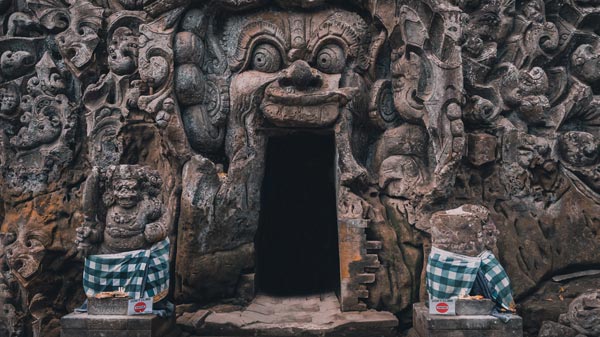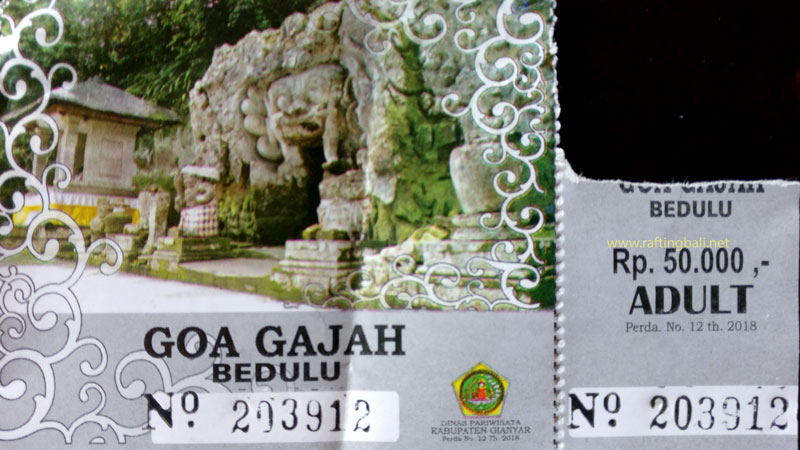Do you want to see ancient carving reliefs in Bali? If yes, visit Goa Gajah Temple Ubud / The Elephant Cave Temple! Therefore, on this page, you can find information about the location of The Elephant Cave Temple with a map. Also, entrance fees and how to get to the site.
Bahasa Indonesia, Goa Gajah Ubud Bali.

Furthermore, Bali’s tourist destination is not just well-known for the breathtaking Bali Dreamland beach or for watching Kecak dance performances in the Uluwatu temple. One of Ubud Bali’s most beautiful and most visited tourist attractions is Goa Gajah, The Elephant Cave Temple.
Daily, The Elephant Cave Temple Ubud always gets many visitors, mostly foreign tourists from Europe and China, as well as domestic tourists. There are reasons why Many tourists visit the Elephant Cave Temple Ubud. It offers unique Balinese Hindu temple architecture, and the temple location is close to Kintamani and Tegalalang rice fields.
Read More On: “The Best Things To Do In Ubud Bali” >>>
History Of Goa Gajah Temple
Furthermore, the Word Goa Gajah is derived from “Lwa Gajah,” a Buddhist monastery on the river’s edge. In the Negarakertagama manuscript, written by Mpu Prapanca in 1.365 C, the word “Lwa Gajah” was stated.
Visitors must step down the stairs from the parking area to locate the Goa Gajah temple. Green and shady trees surround the temple, creating beautiful scenery and a cold air environment. According to the employee who works there, the trees are hundreds of years old. The whole area of Goa Gajah is seen from the stairs.
When you arrive down, you can hear the sound of water gently falling from the stone statue. The stones are from the reminiscence of the collapsed building due to an earthquake found near the shower, and Goa Gajah Ubud is not far from that shower.
The temple entrance gate is from the cave’s mouth and can only be passed by one person. The inner side of the cave has a form T-shaped letter and has space 2 meters in height and 2 meters wide. Hidden caves and niches are predicted as meditation places on the left and right sides. However, visitors can sit or lie down over there. Also, there is a Ganesha statue on the west alley, and in the east lane, you can see three holy phallus.
Moreover, there is a holy water figure around the cave with male and female fairies holding holy water — some statues symbolising seven rivers in India.
Read More, Saraswati Temple Ubud.
Temple Location
Goa Gajah temple Ubud location is on the west side of Bedulu village, Blahbatuh district, Gianyar regency. It is about 26 km from Denpasar city. The exact location is on the cliff’s edge and is the point meeting of a small river in Bedulu village.
To make getting to the Elephant Cave Temple Ubud location easier, please click the link below.
See Here, ”Goa Gajah Temple Google Map” >>>
Opening Hours & Best Time To Visit
The Goa Gajah temple is open for public visitors from 08:00 – 17:00. Most of the time, visitors typically spend around 20 minutes to 1 hour at the Goa Gajah temple.
My recommendation regarding the best time to visit the temple is from 08:00 – 10:00 or in the afternoon around 15:00 – 16:00. Due to during that time, there are fewer visitors around.
Goa Gajah Temple Entrance Fee

To enter The Elephant Cave Temple and see their ancient carving made in the 9th century, you must pay the Goa Gajah temple entrance fee. Below is the Goa Gajah temple entrance fee for international travellers.
| Category | Price |
|---|---|
| Domestic Adult | Rp 30,000 / person |
| Domestic Child | Rp 15,000 / person |
| Foreign Adult | Rp 50,000 / person |
| Foreign Child | Rp 25,000 / person |
| Car Parking | Rp 5,000 / car |
| Motorcycle Parking | Rp 2,000 / motorcycle |
Please note the entrance ticket may change at any time without prior notice. Therefore, admission price differences may occur at any time.
The seller will offer Sarong at the car park for you to buy. Please be informed that Sarong is included in the Goa Gajah entrance fee, so you only need to buy it if you don’t want to wear Sarong that other people have used.
Goa Gajah Dress Code
Balinese Hindu Temples is a secret place for Balinese and one part of Balinese culture. Each international visitor recognises how Balinese people pray to God by visiting a Balinese temple.
Every temple in Bali is a holy site for Balinese Hindus. Therefore, rules apply for a visitor to enter; no exceptions; the restrictions also apply to Balinese. One of the conditions that you need to acknowledge is the temple dress code. Balinese temple dress code is simple; all you need to do is to wear a sarong and sash. It would be best if you tied the waistband on your waist.
Must Read: “Tirta Empul Tampak Siring Temple Bali” >>>
Best Way To Get The Location
Taximeter is the common public transportation in Bali to get to the Goa Gajah elephant cave temple. If you stay in Ubud Bali, the taximeter fee will not be too expensive. But if your hotel is in Kuta or Nusa Dua, using a taximeter will increase your transportation budget.
Therefore, the best way to get to the Goa Gajah elephant cave temple’s location is by private transport, such as a motorbike, self-driving a private car, or car rental with a driver in Bali.
Also, hiring a driver in Bali with a car and fuel is IDR 700.000 / 12 hours. In 12 hours, you can visit many places besides Goa Gajah elephant cave temples. Such as Kintamani, Tegalalang, and Ubud it’s self.
If you have opinions and suggestions on this page, please don’t hesitate to leave your comments below.
Read More: “Gunung Kawi Bali – The Oldest Balinese Ancient Hindu Temple In Ubud” >>>

 4 Days Honeymoon Itinerary in Bali: Unveil Your Romantic Escape
4 Days Honeymoon Itinerary in Bali: Unveil Your Romantic Escape